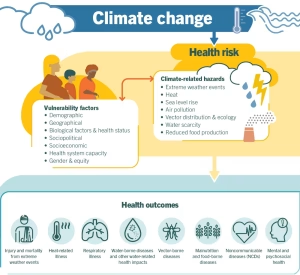Climate change is causing ever more disruption. Can Australia’s new adaptation plan help? – The Conversation

Report on Australia’s National Adaptation Plan and Alignment with Sustainable Development Goals
Introduction: The Imperative for Climate Action (SDG 13)
Australia’s new National Adaptation Plan has been developed in response to projections of global warming levels reaching 2°C to 3°C by the end of the century, with national temperatures expected to exceed the global average. This initiative directly addresses the urgent call for action outlined in SDG 13 (Climate Action). The plan, informed by the National Climate Risk Assessment, acknowledges that Australia must adapt not only to the current 1.3°C of warming but also to future changes locked in by existing and future emissions. Climate adaptation strategies are critical for building resilience and must be implemented in conjunction with significant emission reduction efforts to achieve sustainable development outcomes.
Analysis of the National Adaptation Plan Framework
Strengths and Contributions to Sustainable Development
The plan presents several positive elements that align with various Sustainable Development Goals:
- Governance and Partnerships (SDG 17): The plan clarifies the responsibilities of different tiers of government, establishing a framework for coordinated action.
- Resilient Infrastructure (SDG 9 & SDG 11): A welcome focus is placed on “betterment,” which involves rebuilding infrastructure post-disaster to higher standards of resilience against future climate events. This supports the development of sustainable and resilient infrastructure.
- Sustainable Finance (SDG 8): The plan seeks to direct private finance towards adaptation measures by including them in Australia’s sustainable finance classification system, fostering economic resilience and growth.
- Ecosystem-Based Solutions (SDG 14 & SDG 15): The plan supports nature-based solutions, such as the Urban Rivers and Catchments program and the planting of mangroves, which protect terrestrial and marine ecosystems while enhancing community resilience.
Identified Gaps and Challenges
Despite its strengths, the plan exhibits several deficiencies that may hinder the achievement of comprehensive climate resilience:
- Lack of Proportionality: Proposed future actions are not clearly defined and may not be proportionate to the scale of the climate challenge facing the nation.
- Delayed Monitoring and Evaluation: A significant gap is the multi-year delay in establishing a monitoring and tracking system. This postpones the ability to assess the effectiveness of adaptation actions and make evidence-based adjustments, a crucial component of achieving SDG targets.
- Absence of Clear Metrics: The plan lacks specific metrics for measuring progress, a standard practice in nations with advanced climate legislation like the United Kingdom and Finland.
Key Sectoral Implications and SDG Alignment
Agriculture and Food Security (SDG 2)
While Australian farmers have demonstrated adaptability to past climate changes, the report indicates that existing strategies are unlikely to suffice against future large-scale impacts. To ensure long-term food security and achieve SDG 2 (Zero Hunger), significant investment in research and development is required to pioneer the next generation of agricultural adaptation technologies and practices.
Sustainable Cities and Communities (SDG 11)
The plan addresses the resilience of communities, particularly in coastal areas facing erosion and urban centres managing flood risk. The rebuilding of infrastructure like bridges and the implementation of disaster-ready funding are crucial for SDG 11 (Sustainable Cities and Communities). However, the plan is light on details regarding critical decisions, such as the potential relocation of infrastructure and communities, and who bears the associated costs.
Recommendations for Enhancing Plan Efficacy
Strategic Priorities for Future Action
To transform the National Adaptation Plan from a foundational document into an effective strategic tool, the following actions are recommended:
- Invest in Human Capital (SDG 8): Prioritise the development of a workforce equipped with climate adaptation knowledge and skills across all economic sectors to drive a just transition and sustainable economic growth.
- Strengthen the Evidence Base (SDG 9): Increase investment in climate adaptation science to ensure all sectors have a robust evidence base and a portfolio of viable adaptation options, fostering innovation and resilience.
- Implement Progress Indicators: Accelerate the development and implementation of clear indicators to track progress on adaptation. This will ensure accountability and facilitate effective, data-driven decision-making in pursuit of SDG 13.
The report underscores that there is no time to lose. Enhancing government capabilities and ensuring better integration across sectors and levels of government are essential to get ahead of escalating climate risks and build a prosperous, well-adapted Australia aligned with the Sustainable Development Goals.
Analysis of the Article in Relation to Sustainable Development Goals
1. Which SDGs are addressed or connected to the issues highlighted in the article?
The article primarily focuses on Australia’s national climate adaptation plan, which directly and indirectly connects to several Sustainable Development Goals (SDGs). The main SDGs addressed are:
- SDG 13: Climate Action: This is the central theme of the article. The entire text discusses Australia’s strategy for adapting to the impacts of climate change, such as rising temperatures and extreme weather events. It analyzes the government’s “National Adaptation Plan” and “National Climate Risk Assessment.”
- SDG 9: Industry, Innovation and Infrastructure: The article highlights the need for resilient infrastructure. It mentions “rebuilding flood-damaged bridges to tolerate more extreme conditions” and the concept of “betterment,” which involves upgrading infrastructure after disasters to withstand future climate impacts.
- SDG 11: Sustainable Cities and Communities: The article touches upon making human settlements resilient. It refers to the “Urban Rivers and Catchments program greening city rivers” and the challenges coastal councils face with erosion, implying the need for sustainable urban planning and disaster risk reduction in communities.
- SDG 2: Zero Hunger: The impact of climate change on agriculture is explicitly mentioned. The article notes that while Australian farmers have been adapting, “existing adaptation options are unlikely to be able to meet the rapid, large-scale changes likely to arrive,” pointing to the need for resilient agricultural practices to ensure food security.
- SDG 14: Life Below Water & SDG 15: Life on Land: The article discusses nature-based solutions as a key adaptation strategy. It gives the example of “planting mangroves to slow coastal erosion” and using natural systems to “slow floodwaters,” which relate to the protection and restoration of coastal and terrestrial ecosystems.
2. What specific targets under those SDGs can be identified based on the article’s content?
Based on the issues discussed, several specific SDG targets can be identified:
- Target 13.1: Strengthen resilience and adaptive capacity to climate-related hazards and natural disasters in all countries.
- Explanation: The article is fundamentally about this target. It discusses Australia’s plan to adapt to “global warming levels of 2°C to 3°C” and mentions specific adaptation measures like “rebuilding flood-damaged bridges,” “planting mangroves to slow coastal erosion,” and implementing “early warning systems for disasters.”
- Target 13.2: Integrate climate change measures into national policies, strategies and planning.
- Explanation: The article’s focus on the “National Adaptation Plan” and the “National Climate Risk Assessment” is a direct example of this target in action. It analyzes the government’s effort to create a national strategy to guide its response to climate change.
- Target 9.1: Develop quality, reliable, sustainable and resilient infrastructure… to support economic development and human well-being.
- Explanation: The article emphasizes the importance of resilient infrastructure through its focus on “‘betterment’ – rebuilding bridges, roads or other infrastructure after a disaster to be better adapted for the next one.”
- Target 11.5: By 2030, significantly reduce the number of deaths and the number of people affected and substantially decrease the direct economic losses… caused by disasters.
- Explanation: The article supports this target by mentioning investments in resilience, such as the “$1 billion Disaster Ready fund,” and citing a report that “$1 spent on resilience returns $9.60 by avoiding future financial, health and social damage.”
- Target 2.4: By 2030, ensure sustainable food production systems and implement resilient agricultural practices that… strengthen capacity for adaptation to climate change, extreme weather, drought, flooding and other disasters.
- Explanation: The article directly addresses this by stating the need to “invest in the research and development to enable the next generation of agricultural adaptation” because current methods may not be sufficient for future climate changes.
- Target 14.2 & 15.3: These targets relate to protecting and restoring coastal and terrestrial ecosystems.
- Explanation: The article mentions “nature-based solutions” as a key adaptation strategy, specifically citing “planting mangroves to slow coastal erosion” (Target 14.2) and using natural landscapes to “slow floodwaters” (Target 15.3).
3. Are there any indicators mentioned or implied in the article that can be used to measure progress towards the identified targets?
The article explicitly criticizes the plan for being “quite light on in terms of metrics” and calls for the “rapid development of indicators to be able to track progress on adaptation.” However, it does mention or imply several potential indicators:
- Financial Investment in Adaptation: The article mentions specific financial figures, such as “A$3.6 billion in spending since 2022” and “a further $9 billion by decade’s end” on policies that can support adaptation. It also discusses the goal of directing “private finance to climate adaptation measures.” These financial flows can serve as an indicator of commitment and action.
- Cost-Benefit Analysis / Return on Investment: The article cites an Insurance Council of Australia report that “estimates $1 spent on resilience returns $9.60 by avoiding future financial, health and social damage.” This return on investment (ROI) is a powerful indicator for measuring the effectiveness and economic viability of adaptation projects.
- Development and Implementation of National/Local Policies: The existence and ongoing development of the “National Adaptation Plan” and “National Climate Risk Assessment” are themselves indicators of progress under Target 13.2. The article suggests that progress could be measured by how these plans are built upon and lead to “clear workplans.”
- Temperature Tracking: The article frames the entire problem around temperature increases, mentioning the “existing 1.3°C of climate change” and the need to plan for “2°C to 3°C.” While a global indicator, tracking national and global temperature averages is a fundamental measure of the scale of the climate challenge that adaptation must meet.
4. Table of SDGs, Targets, and Indicators
| SDGs | Targets | Indicators (Mentioned or Implied in the Article) |
|---|---|---|
| SDG 13: Climate Action | 13.1: Strengthen resilience and adaptive capacity to climate-related hazards. 13.2: Integrate climate change measures into national policies. |
– Amount of public and private finance invested in adaptation (e.g., “$3.6 billion in spending”). – Existence and implementation of a National Adaptation Plan. |
| SDG 9: Industry, Innovation and Infrastructure | 9.1: Develop quality, reliable, sustainable and resilient infrastructure. | – Number of infrastructure projects rebuilt using “betterment” principles to withstand future climate conditions. |
| SDG 11: Sustainable Cities and Communities | 11.5: Reduce economic losses and people affected by disasters. | – Return on investment (ROI) for resilience measures (e.g., “$1 spent returns $9.60”). – Funding allocated to disaster readiness funds (e.g., “$1 billion Disaster Ready fund”). |
| SDG 2: Zero Hunger | 2.4: Ensure sustainable food production and implement resilient agricultural practices. | – Investment in research and development for agricultural adaptation. |
| SDG 14 & 15: Life Below Water & Life on Land | 14.2 & 15.3: Protect and restore coastal and terrestrial ecosystems. | – Number and scale of nature-based solution projects implemented (e.g., mangrove planting, river greening). |
Source: theconversation.com

What is Your Reaction?
 Like
0
Like
0
 Dislike
0
Dislike
0
 Love
0
Love
0
 Funny
0
Funny
0
 Angry
0
Angry
0
 Sad
0
Sad
0
 Wow
0
Wow
0



















































.jpg.webp?itok=0ZsAnae9#)
























